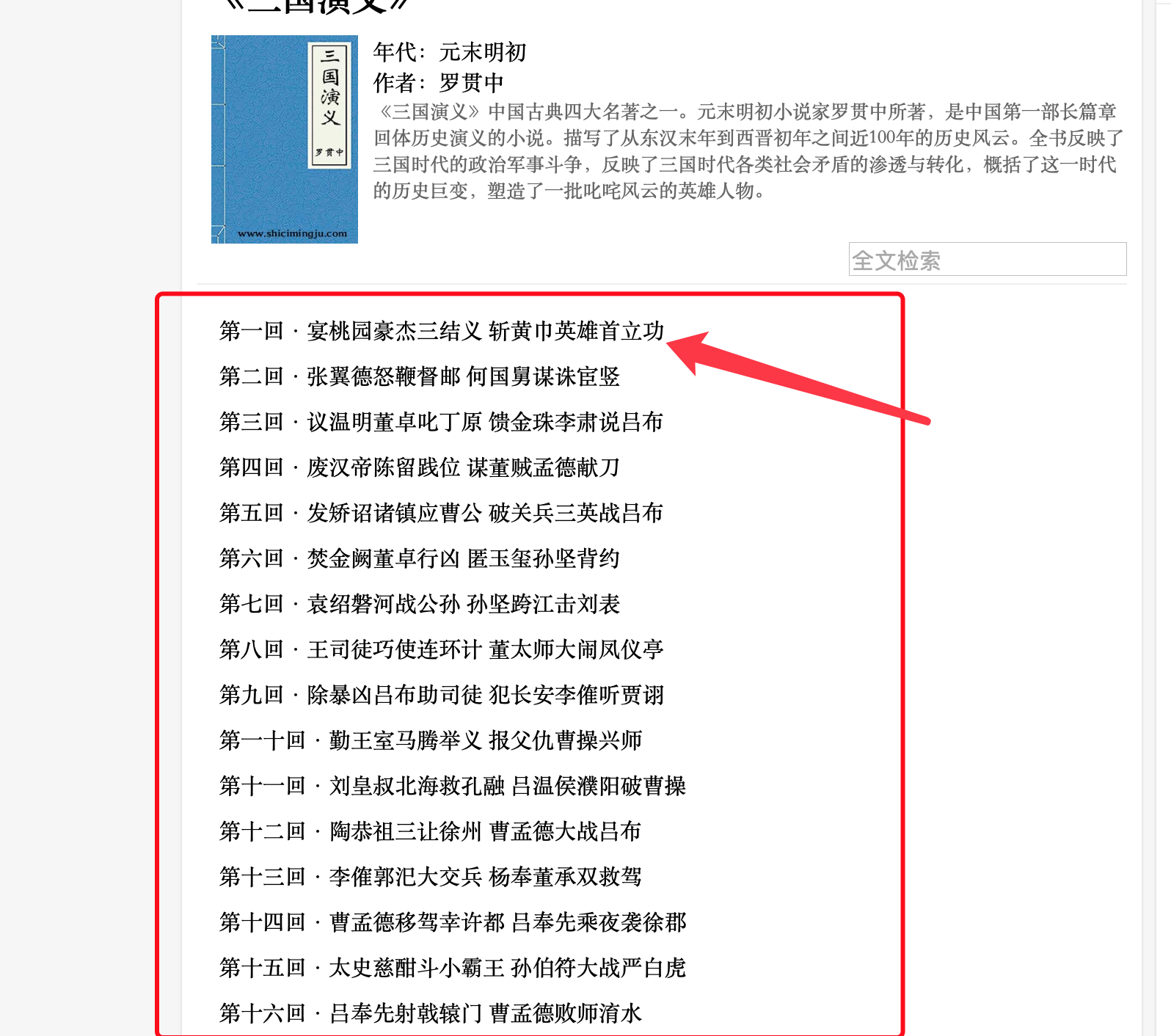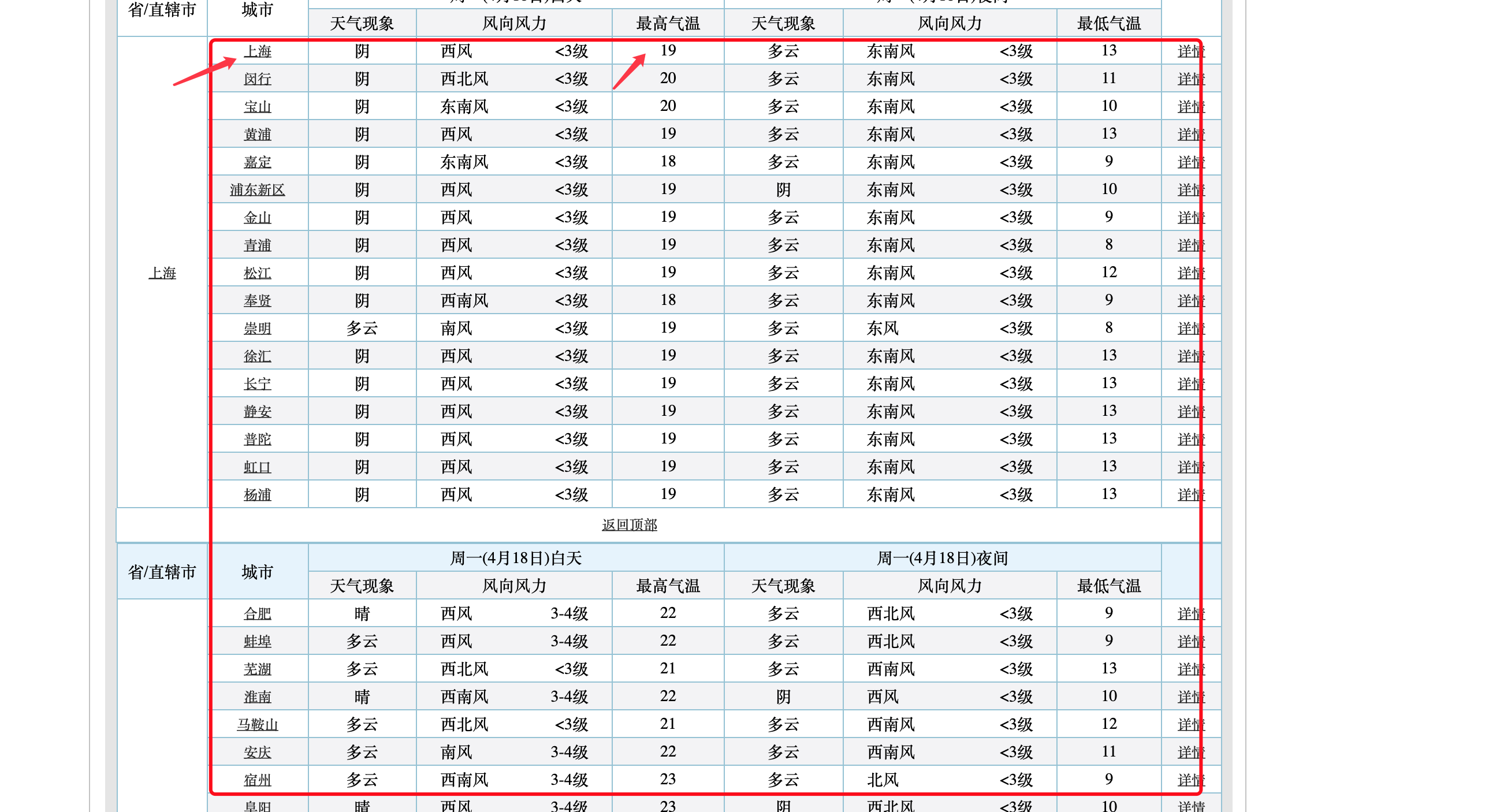Beautifulsoup
beautifulsoup
Docs https://www.crummy.com/software/BeautifulSoup/bs4/doc/
中文版 https://www.crummy.com/software/BeautifulSoup/bs4/doc.zh/
一、beautifulsoup 的简单使用
简单来说,Beautiful Soup 是 Python 的一个库,最主要的功能是从网页抓取数据。官方解释如下:
Beautiful Soup 提供一些简单的、python 式的函数用来处理导航、搜索、修改分析树等功能。它是一个工具箱,通过解析文档为用户提供需要抓取的数据,因为简单,所以不需要多少代码就可以写出一个完整的应用程序。
1、安装
1
pip install beautifulsoup4
或者换源安装
1
pip install beautifulsoup4 -i http://pypi.douban.com/simple/
1.1 解析器
Beautiful Soup 支持 Python 标准库中的 HTML 解析器,还支持一些第三方的解析器,如果我们不安装它,则 Python 会使用 Python 默认的解析器,lxml 解析器更加强大,速度更快,推荐安装。
1
pip install lxml
1.2 解析器对比
2、快速开始
下面的一段 HTML 代码将作为例子被多次用到,这是 爱丽丝梦游仙境的 的一段内容(以后内容中简称为 爱丽丝 的文档):
1
2
3
4
5
6
7
8
9
10
11
12
13
html_doc = """
<html><head><title>The Dormouse's story</title></head>
<body>
<p class="title"><b>The Dormouse's story</b></p>
<p class="story">Once upon a time there were three little sisters; and their names were
<a href="http://example.com/elsie" class="sister" id="link1">Elsie</a>,
<a href="http://example.com/lacie" class="sister" id="link2">Lacie</a> and
<a href="http://example.com/tillie" class="sister" id="link3">Tillie</a>;
and they lived at the bottom of a well.</p>
<p class="story">...</p>
"""
使用 BeautifulSoup 解析这段代码,能够得到一个BeautifulSoup的对象,并能按照标准的缩进格式的结构输出:
1
2
3
4
from bs4 import BeautifulSoup
soup = BeautifulSoup(html_doc, 'lxml')
# html进行美化
print(soup.prettify())
代码输出的结果如下:
1
2
3
4
5
6
7
8
9
10
11
12
13
14
15
16
17
18
19
20
21
22
23
24
25
26
27
28
29
30
31
32
33
<html>
<head>
<title>
The Dormouse's story
</title>
</head>
<body>
<p class="title">
<b>
The Dormouse's story
</b>
</p>
<p class="story">
Once upon a time there were three little sisters; and their names were
<a class="sister" href="http://example.com/elsie" id="link1">
Elsie
</a>
,
<a class="sister" href="http://example.com/lacie" id="link2">
Lacie
</a>
and
<a class="sister" href="http://example.com/tillie" id="link3">
Tillie
</a>
;
and they lived at the bottom of a well.
</p>
<p class="story">
...
</p>
</body>
</html>
几个简单的浏览结构化数据的方法:
1
2
3
4
5
6
7
8
9
10
11
12
13
14
15
16
17
18
19
20
21
22
23
24
25
26
27
28
29
soup.title # 获取标签 title
# <title>The Dormouse's story</title>
soup.title.name # 获取标签名称
# 'title'
soup.title.string # 获取标签 title 内的内容
# 'The Dormouse's story'
soup.title.parent # 获取父级标签
soup.title.parent.name # 获取父级标签名称
# 'head'
soup.p
# <p class="title"><b>The Dormouse's story</b></p>
soup.p['class'] # 获取 p 的 class 属性值
# 'title'
soup.a
# <a class="sister" href="http://example.com/elsie" id="link1">Elsie</a>
soup.find_all('a')
# [<a class="sister" href="http://example.com/elsie" id="link1">Elsie</a>,
# <a class="sister" href="http://example.com/lacie" id="link2">Lacie</a>,
# <a class="sister" href="http://example.com/tillie" id="link3">Tillie</a>]
soup.find(id="link3") # 获取 id 为 link3 的标签
# <a class="sister" href="http://example.com/tillie" id="link3">Tillie</a>
从文档中找到所有<a>标签的链接:
1
2
3
4
5
for link in soup.find_all('a'):
print(link.get('href'))
# http://example.com/elsie
# http://example.com/lacie
# http://example.com/tillie
从文档中获取所有文字内容:
1
print(soup.get_text())
3、如何使用
将一段文档传入 BeautifulSoup 的构造方法,就能得到一个文档的对象,可以传入一段字符串或一个文件句柄。
1
2
3
4
from bs4 import BeautifulSoup
soup = BeautifulSoup(open("index.html"))
soup = BeautifulSoup("<html>data</html>", 'lxml')
然后,Beautiful Soup 选择最合适的解析器来解析这段文档,如果手动指定解析器那么 Beautiful Soup 会选择指定的解析器来解析文档。
二、beautifulsoup 的遍历文档树
还拿“爱丽丝梦游仙境”的文档来做例子:
1
2
3
4
5
6
7
8
9
10
11
12
13
14
15
16
17
html_doc = """
<html><head><title>The Dormouse's story</title></head>
<body>
<p class="title"><b>The Dormouse's story</b></p>
<p class="story">Once upon a time there were three little sisters; and their names were
<a href="http://example.com/elsie" class="sister" id="link1">Elsie</a>,
<a href="http://example.com/lacie" class="sister" id="link2">Lacie</a> and
<a href="http://example.com/tillie" class="sister" id="link3">Tillie</a>;
and they lived at the bottom of a well.</p>
<p class="story">...</p>
"""
from bs4 import BeautifulSoup
# lxml 和 html.parser 解析的有时候会根据 html 是否完整而有解析不同的问题,需要注意
soup = BeautifulSoup(html_doc, 'html.parser')
通过这段例子来演示怎样从文档的一段内容找到另一段内容
1、子节点
一个 Tag 可能包含多个字符串或其它的 Tag,这些都是这个 Tag 的子节点。Beautiful Soup提供了许多操作和遍历子节点的属性。
注意: Beautiful Soup 中字符串节点不支持这些属性,因为字符串没有子节点。
.contents
tag 的.contents属性可以将 tag 的子节点以列表的方式输出:
1
2
3
4
5
6
7
8
9
10
11
12
head_tag = soup.head
head_tag
# <head><title>The Dormouse's story</title></head>
head_tag.contents
# [<title>The Dormouse's story</title>]
title_tag = head_tag.contents[0]
title_tag
# <title>The Dormouse's story</title>
title_tag.contents
# [u'The Dormouse's story']
字符串没有.contents属性,因为字符串没有子节点:
1
2
3
text = title_tag.contents[0]
text.contents
# AttributeError: 'NavigableString' object has no attribute 'contents'
2、 节点内容
2.1 .string
如果 tag 只有一个NavigableString类型子节点,那么这个 tag 可以使用.string得到子节点。如果一个 tag 仅有一个子节点,那么这个 tag 也可以使用.string方法,输出结果与当前唯一子节点的.string结果相同。
通俗点说就是:如果一个标签里面没有标签了,那么.string就会返回标签里面的内容。如果标签里面只有唯一的一个标签了,那么.string也会返回最里面的内容。例如:
1
2
3
4
5
print(soup.head.string)
# The Dormouse's story
# <title><b>The Dormouse's story</b></title>
print(soup.title.string)
# The Dormouse's story
如果 tag 包含了多个子节点,tag 就无法确定,.string方法应该调用哪个子节点的内容,.string的输出结果是 None
1
2
print(soup.html.string)
# None
2.2 .text
如果tag包含了多个子节点, text则会返回内部所有文本内容
1
print(soup.html.text)
注意:strings 和 text 都可以返回所有文本内容
区别:
- text 返回内容为字符串类型
- strings 为生成器 generator
3、多个内容
.strings,.stripped_strings属性
3.1 .strings
获取多个内容,不过需要遍历获取,比如下面的例子:
1
2
3
4
5
6
7
8
9
10
11
12
13
14
15
16
17
18
19
20
21
22
23
for string in soup.strings:
print(repr(string))
'''
'\n'
"The Dormouse's story"
'\n'
'\n'
"The Dormouse's story"
'\n'
'Once upon a time there were three little sisters; and their names were\n'
'Elsie'
',\n'
'Lacie'
' and\n'
'Tillie'
';\nand they lived at the bottom of a well.'
'\n'
'...'
'\n'
'''
3.2 .stripped_strings
输出的字符串中可能包含了很多空格或空行,使用.stripped_strings可以去除多余空白内容
1
2
3
4
5
6
7
8
9
10
11
12
13
14
15
16
17
18
for string in soup.stripped_strings:
print(repr(string))
'''
"The Dormouse's story"
"The Dormouse's story"
'Once upon a time there were three little sisters; and their names were'
'Elsie'
','
'Lacie'
'and'
'Tillie'
';\nand they lived at the bottom of a well.'
'...'
'''
4、父节点
继续分析文档树,每个 tag 或字符串都有父节点:被包含在某个 tag 中
.parent
通过.parent属性来获取某个元素的父节点。在例子“爱丽丝”的文档中,<head>标签是<title>标签的父节点:
1
2
3
4
5
title_tag = soup.title
title_tag
# <title>The Dormouse's story</title>
title_tag.parent
# <head><title>The Dormouse's story</title></head>
文档的顶层节点比如<html>的父节点是BeautifulSoup对象:
1
2
3
html_tag = soup.html
type(html_tag.parent)
# <class 'bs4.BeautifulSoup'>
三、beautifulsoup 的搜索文档树
1、find_all()
1
find_all( name , attrs , recursive , string , **kwargs )
find_all()方法搜索当前 tag 的所有 tag 子节点,并判断是否符合过滤器的条件:
1
2
3
4
5
6
7
8
9
10
11
12
13
14
15
soup.find_all("title")
# [<title>The Dormouse's story</title>]
soup.find_all("a")
# [<a class="sister" href="http://example.com/elsie" id="link1">Elsie</a>,
# <a class="sister" href="http://example.com/lacie" id="link2">Lacie</a>,
# <a class="sister" href="http://example.com/tillie" id="link3">Tillie</a>]
soup.find_all(id="link2")
# [<a class="sister" href="http://example.com/lacie" id="link2">Lacie</a>]
import re
# 模糊查询 包含 sisters 的就可以
soup.find(string=re.compile("sisters"))
# 'Once upon a time there were three little sisters; and their names were\n'
有几个方法很相似,还有几个方法是新的,参数中的string和id是什么含义?为什么find_all("p", "title")返回的是 CSS Class 为”title”的<p>标签?
我们来仔细看一下find_all()的参数。
1.1 name 参数
name参数可以查找所有名字为name的tag,字符串对象会被自动忽略掉。
简单的用法如下:
1
2
soup.find_all("title")
# [<title>The Dormouse's story</title>]
搜索name参数的值可以使任一类型的过滤器,字符串,正则表达式,列表,方法或是True 。
<1> 传字符串
最简单的过滤器是字符串。在搜索方法中传入一个字符串参数,Beautiful Soup 会查找与字符串完整匹配的内容,下面的例子用于查找文档中所有的<b>标签
1
2
soup.find_all('b')
# [<b>The Dormouse's story</b>]
<2> 传正则表达式
如果传入正则表达式作为参数,Beautiful Soup 会通过正则表达式的match()来匹配内容。下面例子中找出所有以 b 开头的标签,这表示<body>和<b>标签都应该被找到
1
2
3
4
5
import re
for tag in soup.find_all(re.compile("^b")):
print(tag.name)
# body
# b
<3> 传列表
如果传入列表参数,Beautiful Soup 会将与列表中任一元素匹配的内容返回。下面代码找到文档中所有<a>标签和<b>标签
1
2
3
4
5
soup.find_all(["a", "b"])
# [<b>The Dormouse's story</b>,
# <a class="sister" href="http://example.com/elsie" id="link1">Elsie</a>,
# <a class="sister" href="http://example.com/lacie" id="link2">Lacie</a>,
# <a class="sister" href="http://example.com/tillie" id="link3">Tillie</a>]
1.2 keyword 参数
如果一个指定名字的参数不是搜索内置的参数名,搜索时会把该参数当作指定名字 tag 的属性来搜索,如果包含一个名字为id的参数,Beautiful Soup 会搜索每个 tag 的”id”属性。
1
2
3
4
5
6
7
8
9
10
11
12
soup.find_all(id='link2')
# [<a class="sister" href="http://example.com/lacie" id="link2">Lacie</a>]
import re
# 超链接包含 elsie 标签
print(soup.find_all(href=re.compile("elsie")))
# [<a class="sister" href="http://example.com/elsie" id="link1">Elsie</a>]
# 以The作为开头的字符串
print(soup.find_all(text=re.compile("^The")))
# ["The Dormouse's story", "The Dormouse's story"]
# class选择器包含st的节点
print(soup.find_all(class_=re.compile("st")))
搜索指定名字的属性时可以使用的参数值包括字符串,正则表达式,列表, True 。
下面的例子在文档树中查找所有包含id属性的 tag,无论id的值是什么:
1
2
3
4
soup.find_all(id=True)
# [<a class="sister" href="http://example.com/elsie" id="link1">Elsie</a>,
# <a class="sister" href="http://example.com/lacie" id="link2">Lacie</a>,
# <a class="sister" href="http://example.com/tillie" id="link3">Tillie</a>]
使用多个指定名字的参数可以同时过滤 tag 的多个属性:
1
2
soup.find_all(href=re.compile("elsie"), id='link1')
# [<a class="sister" href="http://example.com/elsie" id="link1">three</a>]
在这里我们想用 class 过滤,不过 class 是 Python 的关键词,这怎么办?加个下划线就可以
1
2
3
4
5
6
7
8
9
print(soup.find_all("a", class_="sister"))
'''
[<a class="sister" href="http://example.com/elsie" id="link1">Elsie</a>,
<a class="sister" href="http://example.com/lacie" id="link2">Lacie</a>,
<a class="sister" href="http://example.com/tillie" id="link3">Tillie</a>
]
'''
通过find_all()方法的attrs参数定义一个字典参数来搜索包含特殊属性的 tag:
1
2
data_soup.find_all(attrs={"data-foo": "value"})
# [<div data-foo="value">foo!</div>]
注意:如何查看条件 id 和 class 同时存在时的写法
1
2
print(soup.find_all('b', class_="story", id="x"))
print(soup.find_all('b', attrs={"class":"story", "id":"x"}))
1.3 text 参数
通过text参数可以搜搜文档中的字符串内容。与name参数的可选值一样,text参数接受字符串,正则表达式,列表, True
1
2
3
4
5
6
7
8
9
10
11
import re
print(soup.find_all(text="Elsie"))
# ['Elsie']
print(soup.find_all(text=["Tillie", "Elsie", "Lacie"]))
# ['Elsie', 'Lacie', 'Tillie']
# 只要包含Dormouse就可以
print(soup.find_all(text=re.compile("Dormouse")))
# ["The Dormouse's story", "The Dormouse's story"]
1.4 limit 参数
find_all()方法返回全部的搜索结构,如果文档树很大那么搜索会很慢。如果我们不需要全部结果,可以使用limit参数限制返回结果的数量。效果与 SQL 中的 limit 关键字类似,当搜索到的结果数量达到 limit的限制时,就停止搜索返回结果。
1
2
3
4
5
6
7
print(soup.find_all("a",limit=2))
print(soup.find_all("a")[0:2])
'''
[<a class="sister" href="http://example.com/elsie" id="link1">Elsie</a>,
<a class="sister" href="http://example.com/lacie" id="link2">Lacie</a>]
'''
2、find()
1
find( name , attrs , recursive , string , **kwargs )
find_all() 方法将返回文档中符合条件的所有tag,尽管有时候我们只想得到一个结果。比如文档中只有一个<body>标签,那么使用 find_all() 方法来查找<body>标签就不太合适, 使用 find_all 方法并设置 limit=1 参数不如直接使用 find() 方法。下面两行代码是等价的:
1
2
3
4
5
soup.find_all('title', limit=1)
# [<title>The Dormouse's story</title>]
soup.find('title')
# <title>The Dormouse's story</title>
唯一的区别是 find_all() 方法的返回结果是值包含一个元素的列表,而 find() 方法直接返回结果。
find_all() 方法没有找到目标是返回空列表, find() 方法找不到目标时,返回 None 。
1
2
print(soup.find("nosuchtag"))
# None
soup.head.title 是 tag 的名字方法的简写。这个简写的原理就是多次调用当前 tag 的find()方法:
1
2
3
4
5
soup.head.title
# <title>The Dormouse's story</title>
soup.find("head").find("title")
# <title>The Dormouse's story</title>
四、beautifulsoup 的 css 选择器
我们在写 CSS 时,标签名不加任何修饰,类名前加点,id 名前加 #,在这里我们也可以利用类似的方法来筛选元素,用到的方法是 soup.select(),返回类型是 list
1、通过标签名查找
1
2
print(soup.select("title")) #[<title>The Dormouse's story</title>]
print(soup.select("b")) #[<b>The Dormouse's story</b>]
2、通过类名查找
1
2
3
4
5
6
7
8
print(soup.select(".sister"))
'''
[<a class="sister" href="http://example.com/elsie" id="link1">Elsie</a>,
<a class="sister" href="http://example.com/lacie" id="link2">Lacie</a>,
<a class="sister" href="http://example.com/tillie" id="link3">Tillie</a>]
'''
3、id 名查找
1
2
print(soup.select("#link1"))
# [<a class="sister" href="http://example.com/elsie" id="link1">Elsie</a>]
4、组合查找
组合查找即和写 class 文件时,标签名与类名、id名进行的组合原理是一样的,例如查找 p 标签中,id 等于 link1 的内容,二者需要用空格分开
1
2
3
print(soup.select("p #link2"))
#[<a class="sister" href="http://example.com/lacie" id="link2">Lacie</a>]
直接子标签查找
1
2
print(soup.select("p > #link2"))
# [<a class="sister" href="http://example.com/lacie" id="link2">Lacie</a>]
查找既有 class 也有 id 选择器的标签
1
a_string = soup.select(".story#test")
查找有多个 class 选择器的标签
1
a_string = soup.select(".story.test")
查找有多个 class 选择器和一个 id 选择器的标签
1
a_string = soup.select(".story.test#book")
5、属性查找
查找时还可以加入属性元素,属性需要用中括号括起来,注意属性和标签属于同一节点,所以中间不能加空格,否则会无法匹配到。
1
2
print(soup.select("a[href='http://example.com/tillie']"))
#[<a class="sister" href="http://example.com/tillie" id="link3">Tillie</a>]
select()方法返回的结果都是列表形式,可以遍历形式输出,然后用get_text()方法来获取它的内容:
1
2
3
4
5
6
7
8
for title in soup.select('a'):
print (title.get_text())
'''
Elsie
Lacie
Tillie
'''
练习
1、匹配三国演义中的回合并写入 html 文本中
2、匹配天气信息城市与温度
只要城市与气温
匹配后结果为
3、匹配广州二手房房源信息
匹配红色框内的内容



